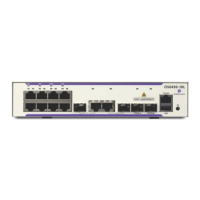OmniSwitch AOS Release 7 Network Configuration Guide March 2011 page 1133
For example, to send a ping with a count of 2, a size of 32 bytes, an interval of 2 seconds, time-out of 10
seconds, a sourec-interface using mgmt, tos of 1, data-pattern of AB and dont-fragment you would enter:
-> ping 172.22.2.115 count 2 size 32 interval 2 timeout 10 source-interface mgmt
tos 1 data-pattern AB dont-fragment
Note. If you change the default values, they only apply to the current ping. The next time you use the ping
command, the default values are used unless you enter different values again.
Tracing an IP Route
The traceroute command is used to find the path taken by an IP packet from the local switch to a speci-
fied destination. This command displays the individual hops to the destination as well as some timing
information. When using this command, you must enter the name of the destination as part of the
command line (either the IP address or host name). Use the optional max-hop parameter to set a maxi-
mum hop count to the destination. If the trace reaches this maximum hop count without reaching the desti-
nation, the trace stops.
For example, to perform a traceroute to a device with an IP address of 172.22.2.115 with a maximum hop
count of 10 you would enter:
-> traceroute 172.22.2.115 max-hop 10
Optionally, you can also specify:
• min-hop. Use the min-hop keyword to set the minimum number of hops for the first packet.
• source-interface. Use the source-interface keyword to set the source IP interface to be used in the
traceroute packets.
• probes. Use the probes keyword to set the number of packets (retry) that will be sent for each hop-
count.
• timeout. Use the timeout keyword to set the time to wait for the response of each probe packet.
• port. Use the port keyword to set the destination port number to be used in the probing packets.
Displaying TCP Information
Use the show tcp statistics command to display TCP statistics. Use the show tcp ports command to
display TCP port information.
Displaying UDP Information
UDP is a secondary transport-layer protocol that uses IP for delivery. UDP is not connection-oriented and
does not provide reliable end-to-end delivery of datagrams. But some applications can safely use UDP to
send datagrams that do not require the extra overhead added by TCP. Use the show udp statistics
command to display UDP statistics. Use the show udp ports command to display UDP port information.

